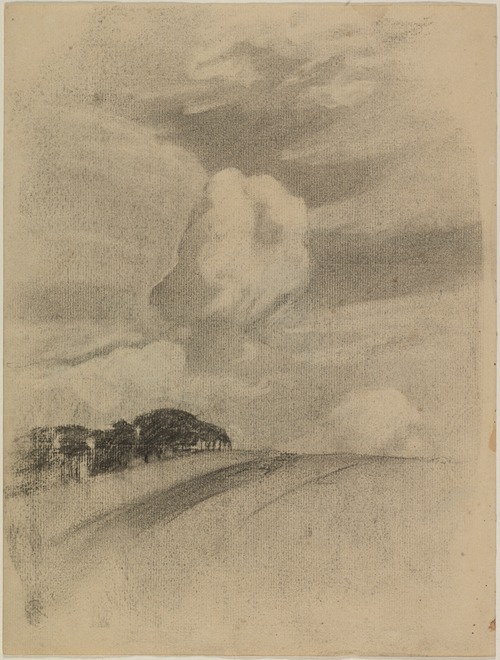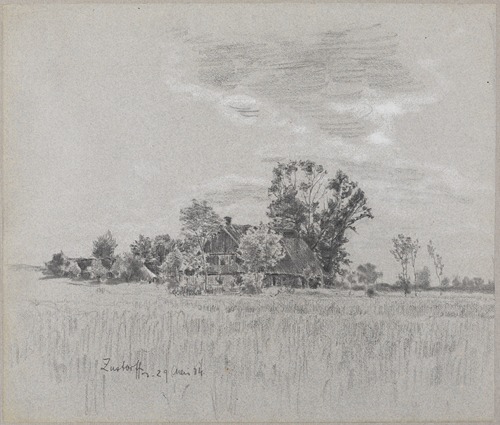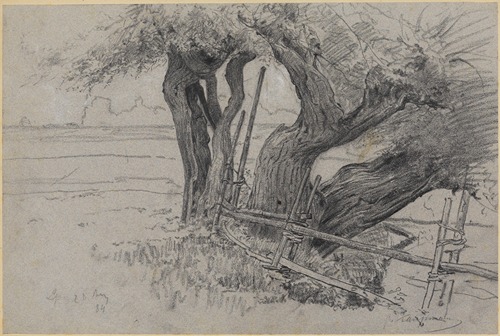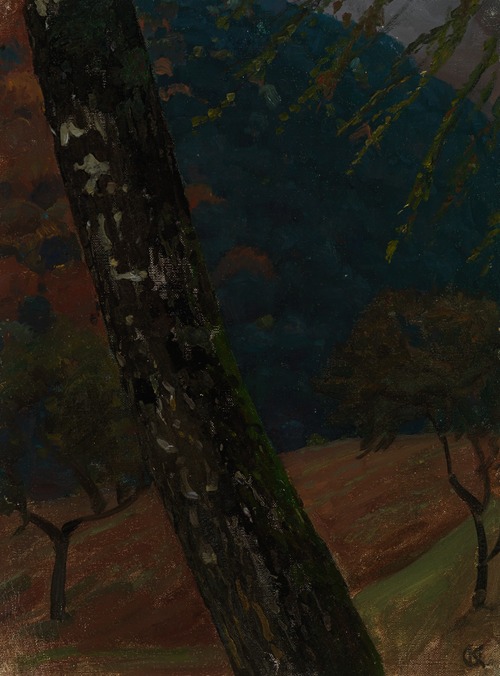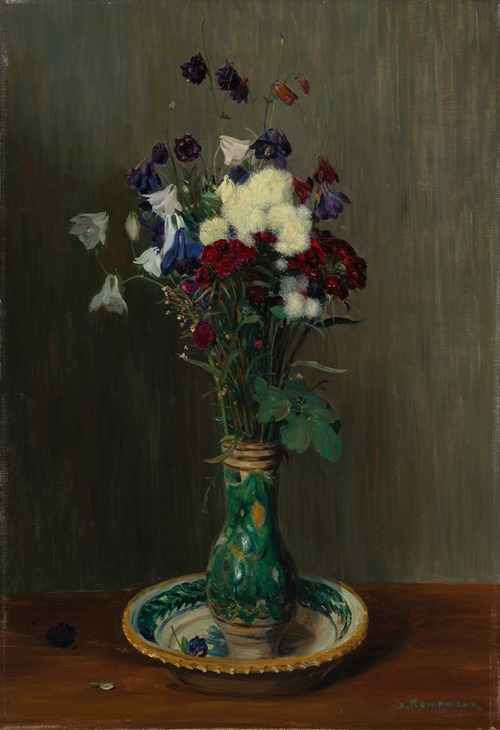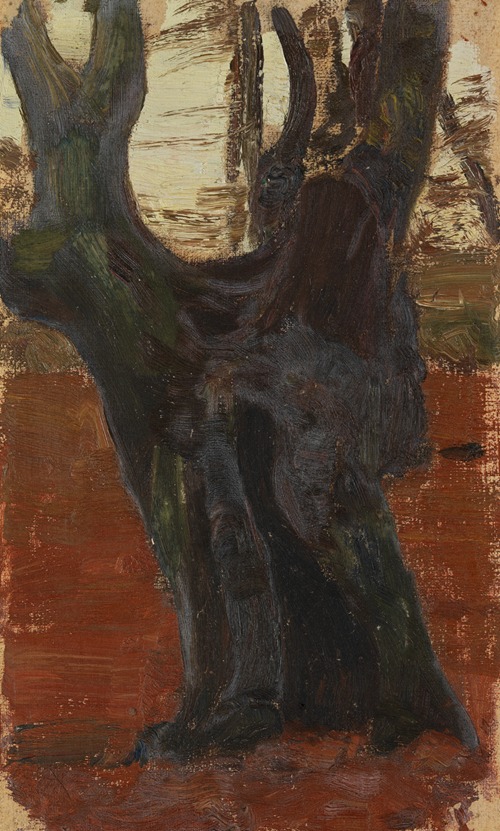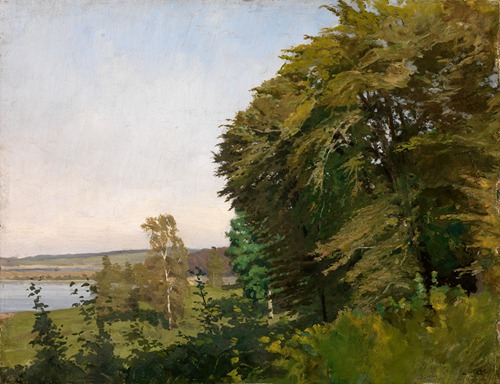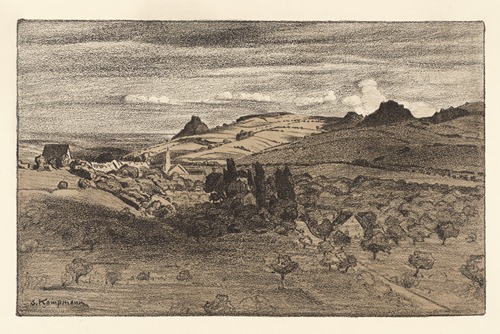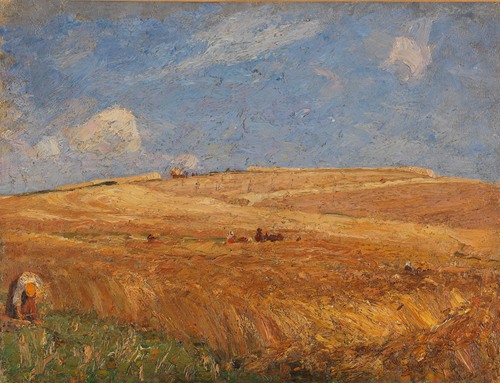
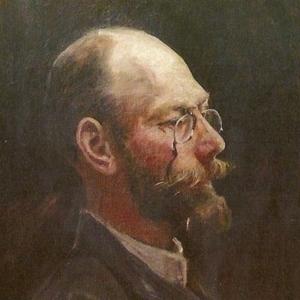
Gustav Kampmann was a landscape painter and graphic artist from Karlsruhe.
As a master student of Gustav Schönleber and Hermann Baisch, Kampmann was a representative of the Karlsruhe Landscape School. He was a founding member and second chairman of the Karlsruher Künstlerbund and is considered the most important member of the Grötzinger Malerkolonie.
Born into a Rhineland family of Protestant denomination in Boppard am Rhein near Koblenz, Gustav Kampmann lived in and near Karlsruhe from 1873. His father was the doctor Wilhelm Kampmann, owner of the Marienberg cold-water works near Boppard. His mother was Elisabeth Nottebohm, née Schmitz. Among Kampmann's seven siblings and half-siblings, his half-sister, the painter Jenny Fikentscher née Nottebohm, daughter of his mother's second marriage to August Nottebohm from Wattenscheid, was significant for Kampmann's life. She later married Otto Fikentscher, the founder of the Grötzingen painters' colony, of which Kampmann is considered to be the most important artistic member.
Kampmann spent part of his childhood in Katowice in Silesia, where his stepfather had been appointed government architect. In Karlsruhe, Kampmann graduated from secondary school in 1878 with the so-called "one-year volunteer" certificate and entered the Grand Ducal-Badische Kunstschule in Karlsruhe in the same year. He remained there until 1884, although he had to interrupt his training in 1880/1881 to complete his one-year voluntary military service. His teachers were first Hans Fredrik Gude, then his successor Gustav Schönleber and finally Hermann Baisch, both of whom were students of the Munich landscape painter Adolf Heinrich Lier. His numerous study trips, which he undertook from various locations from the 1980s onwards, were of great importance for his work as a landscape painter. In 1880 he spent the summer at Lake Constance. From 1885 to 1889 he lived (with an interruption in 1887/88, during which he traveled from Lübeck to the Baltic coast) with his painter friend Bernhard Buttersack in Munich and Schleißheim near Munich, from where he explored the Erdinger Moos, which was popular with landscape painters of the time, and undertook trips in southern Germany.
He took part in his first exhibition at the Royal Academy of Arts in Berlin in 1886. Since then he has regularly participated in exhibitions, first in Munich and then in other major German cities (Akademie der Künste Berlin 1988, 1892; Große Berliner Kunstausstellung 1893, 1898, 1903, 1905, 1908, 1913; Münchner Glaspalast 1889, 1892, 1897, 1898, 1900, 1911, 1912; Münchener Secession 1893, 1896, 1907; Kollektivausstellung Kaiser-Wilhelm-Museum Krefeld 1916). In 1890, he moved to Grötzingen, where he moved into an apartment with his half-sister and his mother in Augustenburg Castle, which Fikentscher had acquired and thus saved from imminent demolition. The Grötzingen painters' colony was founded there. In 1891, he married Anna Roth, a piano teacher born in Basel in 1860, whom he had met during a rheumatism-related stay at the Walensee in Switzerland in 1888. His son Hans-Jürgen was born in 1894. In 1891, he undertook a study trip to Belgium and Holland. In 1895 he explored the northern Black Forest, the Murg Valley and the Hornisgrinde, and the following year the Vosges. In 1898 he visited the Swiss Jura. In 1901, a trip via France and Spain took him to Tangier in Morocco. In 1902, Friedrich Kallmorgen's appointment to Berlin marked the beginning of the dissolution of the Grötzingen painters' colony. The Kampmann couple also moved to Durlach in 1905, but returned to Grötzingen in 1908, no longer living in the Augustenburg but in a small house of their own.
Together with 23 other artists, Kampmann founded the Karlsruher Künstlerbund in 1896 and was elected second chairman in 1899. The Karlsruher Künstlerbund ran its own lithography workshop, the Kunstdruckerei Künstlerbund Karlsruhe, and played a significant role in the successful introduction of the artist's stone drawing in Germany, which pursued the dual aim of making original art affordable for a less well-heeled public by offering inexpensive reproductions instead of cheap reproductions such as oil color printing, thereby contributing to the aesthetic education of the people and securing a more regular income for artists. In line with the popular educational objective, editions of several thousand, and in one case even 10,000, copies of popular prints were produced, contrary to the usual practice of limited editions for artists' prints. Kampmann became an artistic collaborator of the ambitious avant-garde magazine Pan, but he also created commercial art. For example, he was commissioned by the Cologne chocolate producer Ludwig Stollwerck to design collector's pictures for Stollwerck collector's albums, including the Stollwerck collector's albums No. 4 and 5 from 1899 and 1902 respectively.
In 1901 Kampmann received a mention honorable in Paris. In 1904 he joined the Association of Friends of Art in the Rhine countries. In the same year, he received the Small Golden Plaque in Dresden. In 1905, Grand Duke Friedrich I of Baden appointed him titular professor at the Großherzoglich Badische Kunstschule in Karlsruhe after he had declined an appointment as professor at the Königliche Akademie für graphische Künste und Buchgewerbe in Leipzig. In 1909, he spent April to June in Vienna, followed by a study trip to Hegau in 1910, a study trip to the Harz Mountains in 1911 and another to the Rhön in 1912.
In the years before the I. In the years leading up to the First World War, Kampmann was on friendly terms with the liberal politicians Theodor Heuss and Friedrich Naumann, both of whom, as supporters of the art education movement, published appreciative appraisals of his work. In 1914, he moved to Switzerland before the start of the war, but then voluntarily joined the Karlsruhe reserve. From 1915, he suffered from severe corneal inflammation in his left eye, which, in addition to the severe rheumatism he had suffered from since his youth, made painting an ordeal. After he was promoted to captain on February 28, 1916, he was initially given leave to recuperate in Grötzingen from mid-February 1917 and was finally discharged from military service at his own request due to illness. In the same year, Kampmann died by his own hand during a stay at a health resort in Bad Godesberg by opening his wrists. His widow had it published in the newspaper that he had succumbed to his illnesses.
